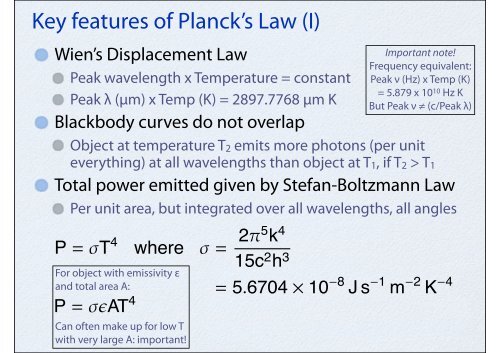Infrared astronomy: an introduction - School of Physics
Infrared astronomy: an introduction - School of Physics
Infrared astronomy: an introduction - School of Physics
You also want an ePaper? Increase the reach of your titles
YUMPU automatically turns print PDFs into web optimized ePapers that Google loves.
Key features <strong>of</strong> Pl<strong>an</strong>ck’s Law (I)<br />
Wien’s Displacement Law<br />
Peak wavelength x Temperature = const<strong>an</strong>t<br />
Peak λ (µm) x Temp (K) = 2897.7768 µm K<br />
Blackbody curves do not overlap<br />
Object at temperature T2 emits more photons (per unit<br />
everything) at all wavelengths th<strong>an</strong> object at T1, if T2 > T1<br />
Total power emitted given by Stef<strong>an</strong>-Boltzm<strong>an</strong>n Law<br />
Per unit area, but integrated over all wavelengths, all <strong>an</strong>gles<br />
P = σT 4 where σ = 2π5 k 4<br />
For object with emissivity ε<br />
<strong>an</strong>d total area A:<br />
P = σɛAT 4<br />
C<strong>an</strong> <strong>of</strong>ten make up for low T<br />
with very large A: import<strong>an</strong>t!<br />
15c 2 h 3<br />
Import<strong>an</strong>t note!<br />
Frequency equivalent:<br />
Peak ν (Hz) x Temp (K)<br />
= 5.879 x 10 10 Hz K<br />
But Peak ν ≠ (c/Peak λ)<br />
= 5.6704 × 10 −8 Js −1 m −2 K −4
















